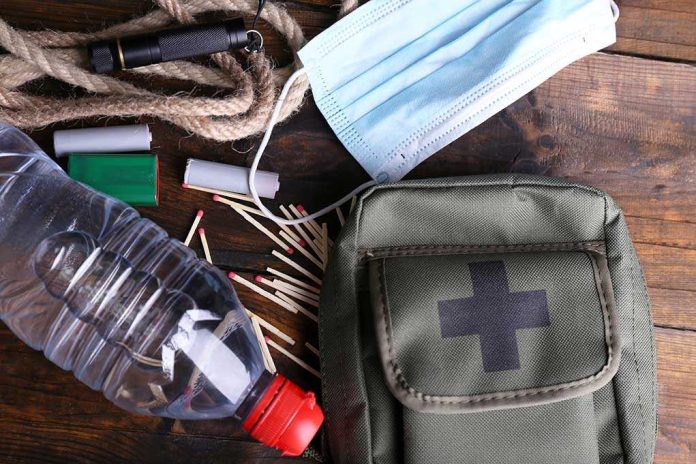
When American aid workers are attacked in Gaza and the U.S. points fingers at Hamas, only to have Hamas flatly deny involvement, you know the story isn’t just about bullets and bandages—it’s about who controls the narrative, who doles out the aid, and who gets blamed when the whole system collapses.
At a Glance
- Two American aid workers from the Gaza Humanitarian Foundation (GHF) were injured in an attack at a Gaza aid site on July 5, 2025.
- The U.S. State Department immediately accused Hamas of orchestrating the attack—Hamas categorically rejected the claim.
- The incident has reignited debates over the politicization of humanitarian aid and the dangerous conditions for workers in Gaza.
- Major humanitarian organizations refuse to recognize the GHF, intensifying the chaos and mistrust around aid distribution.
Another Day, Another Attack—But Who’s Really Protecting the Helpers?
It’s not enough that Gaza is a warzone where food is scarcer than common sense in Washington. Now, even the very people risking their necks to deliver what little aid gets through—American workers, in this case—are targets. On July 5, 2025, two American employees of the Gaza Humanitarian Foundation were caught in an attack at a distribution site. The U.S. government wasted no time blaming Hamas, which, let’s face it, is the default scapegoat for anything that moves (or explodes) in Gaza these days. But in a twist that would make even the most seasoned Beltway cynic roll their eyes, Hamas’s government media office shot back, denying any role in the attack and calling the accusation baseless. Who’s telling the truth? In a place where every side spins the chaos for their own ends, truth is the first casualty—followed closely by those actually trying to help.
Meanwhile, the GHF—propped up by the U.S. and Israel, but not recognized by the UN or any major aid group—continues to operate in the crosshairs. Their presence is supposed to be a solution, but to many Gazans and international observers, they’re just another pawn in the endless power game. So, while Americans are bleeding in the sand, the so-called “legitimate” aid groups won’t touch GHF with a ten-foot pole, citing its ties to occupying powers. This fractured aid apparatus guarantees nothing but more confusion, more risk, and more headlines that make you want to pound your fist on the kitchen table.
Broken Promises and Busted Trust: Aid as a Political Football
The attack is just the latest in a string of violent episodes at Gaza aid distribution sites. Since the beginning of the current conflict in October 2023, more than 278 aid workers have been killed, making it the deadliest period for humanitarian workers in UN history. Israeli military operations, Hamas’s iron grip, and desperate civilians all collide in a brutal contest where food and medicine are weapons and shields alike. The GHF, specifically, has been at the center of controversy. Supported by U.S. and Israeli interests, it’s seen by many locals as an extension of occupation, not a channel for relief.
This isn’t the first time accusations have flown faster than facts. In March 2024, dozens died at another aid site—Israel blamed “armed Palestinians,” while witnesses pointed fingers at Israeli shells. In June 2025, a tank attack at another GHF site left 32 Palestinians dead and 200 wounded. Each incident is followed by a parade of denials, finger-pointing, and empty promises of investigations. The only thing more predictable than the violence is the lack of accountability. And through it all, the U.S. keeps funding, Israel keeps bombing, and Hamas keeps ruling—while ordinary people keep dying, hungry and unheard.
Aid Workers in the Crossfire: The New Normal?
Let’s be honest: if you’re an aid worker in Gaza, you’re now a sitting duck. The breakdown of civil order has turned once-routine food distributions into deadly gambles. Police escorts have vanished, either targeted or too scared to show up. Aid organizations—especially those with any whiff of Western or Israeli backing—are viewed with suspicion by locals and militants alike. The result? Food convoys get looted, civilians stampede distribution sites, and armed groups take potshots at anyone who looks out of place. Welcome to humanitarian aid in 2025, where “neutrality” is just something you read about in outdated Red Cross manuals.
The U.S. State Department’s call for “accountability” rings hollow when the entire aid system is rigged for failure. Major NGOs and the UN refuse to coordinate with GHF, fearing their own reputations and staff safety. This leaves Gaza’s most vulnerable at the mercy of a patchwork of politicized, under-resourced groups. Worse still, the attacks and constant accusations erode what little trust remains between civilians and those trying to help them. The only winners in this mess are the headline writers and politicians who get to look “tough” while doing nothing to fix the root problem.
Sources:
American Immigration Council: House Reconciliation Bill Immigration & Border Security
IDGA: CBP’s Primary Mission Areas in 2025
White House: Securing Our Borders









